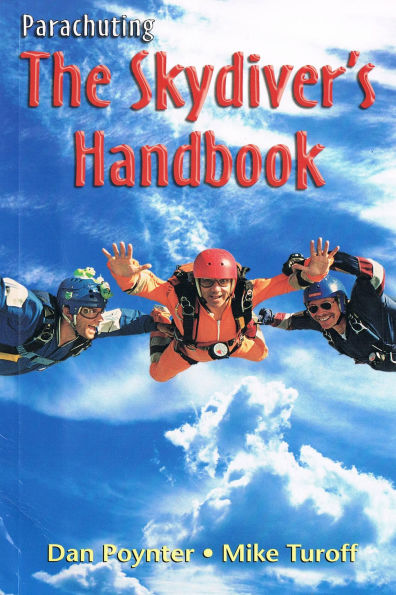

Available on Compatible NOOK devices, the free NOOK App and in My Digital Library.
Related collections and offers
Overview

Product Details
| BN ID: | 2940044477759 |
|---|---|
| Publisher: | Dan Poynter |
| Publication date: | 04/16/2013 |
| Sold by: | Smashwords |
| Format: | eBook |
| File size: | 8 MB |
About the Author
Read an Excerpt
From Chapter One
Jumping is fun! Skydiving is not just falling, it is flying-the closest we have been able to come to free, unencumbered, non-mechanical individual flight. Nearly everyone flies in his or her dreams; the young Idolize Superman while the old admire the birds. Anyone who has sprung from the three meter board, jumped from the hayloft into a haystack, or even stood on a hill in a high wind with arms outstretched has experienced a form of non-mechanical flight. Skydiving, individual and group human flight, Is what this book is all about.
See the equipment chapter and the Glossary in the back of this book for any words that are new to you.
"If riding in an airplane is flying, then riding in a boat Is swimming. If you want to experience the element, get out of the vehicle."
Since skydiving began to catch on as a sport in the late fifties, It has become a well-organized, widely recognized form of aviation activity and is now an established recreational pursuit. Just as airline travel has changed dramatically since Its begInnings back in the early 1900s, advances in techniques and equipment have made the sport of skydiving relatively safe and thoroughly fun.
Equipment. Sport jumpers wear a highly maneuverable main parachute that, when controlled properly, lets them down so softly that they can easily stand up on landing. They usually wear protective clothing: a helmet, a jumpsuit, and perhaps goggles and gloves. They wear an extra reserve parachute for the same reason you use a seat belt in your car-for protection in that rare case when something goes wrong.
Going up. After you suit up, you climb aboard the aircraft with fellow parachutists for a ride to thousands of feet above the ground. The higher you go, the longer your freefall can be. A common freefall time is 60 seconds, starting from 12,500 feet (approximately 3,800 meters) above the ground (also written as AGL or Above Ground LeveL). Once the aircraft reaches the planned jump altitude, the jumpmaster directs the pilot to fly the plane over the proper point (the spot) on the ground so that even with some wind, you can land on target. Then out you go! Skydiving. After leaving a perfectly good airplane, you will accelerate for eleven seconds until you reach about 110 mph downward, which Is nominal terminal velocity, that speed at which the pull of gravity (force on your body) equals your wind resistance. You will continue to fall at this same speed unless you alter your body position. We will explain why later.
Does it feel as if you are falling? No-it's more like laying on a very noisy, partially deflated air mattress. Although you reach 110 miles per hour in a belly-to-earth "stable" (arched) position (or even 200 miles per hour in a head-down dive), you merely feel the pressure of the air against your body. It is a simple matter to use that air pressure to perform loops and rolls and even to track (move horizontally) across the ground. Experienced jumpers frequently exit the airplane with fellow jumpers, then by maneuvering their bodies, join in countless formations, and they still have time to move away from each other to open their parachutes in an uncrowded sky.
After checking your altimeter, you end your freefall by deploying your parachute at 2,500 feet (approximately 760 m) AGL. A rustle of nylon and a tug at the shoulders-and then there is the rapid flutter of your slider as you hang beneath a multi-colored nylon wing for the two to three minute ffight to the landing area.
The canopy ride. When you deploy your parachute, you suddenly increase the ten square feet of air resistance of your body to approximately 250 square feet of drag provided by a nylon canopy measuring some 11 x 23 feet. This wing-like soft nylon structure descends at 20 feet per second and may be flared like an airplane for a soft, tip-toe landing. The ground below Is a panorama of color. The air smells fresh and there is a constant wind in your face due to the forward flight of the canopy.
Landings may be like hopping off a cable car or, if you are not from San Francisco, like jumping off the rear bumper of a truck moving slowly at 3 to 5 mph. It' is not hard, but tricky because of the horizontal movement produced by the wind and the forward motion of the canopy. As you gain experience, your landings will become softer and more precise. By flaring your canopy at just the right moment, you will land just like a bird on a branch. Skydiving isn't as rough and tumble as its Army Airborne heritage would lead you to believe.
It must be remembered that the combat-scarred airborne trooper jumping into battle is using the parachute only as transportation; for him it is the fastest, safest and simplest way down. His physical conditioning prepares him for the mission, which begins after the jump. Sport parachuting is considerably easier; anyone in reasonably good physical condition may participate.
Table of Contents
Table of ContentsChapter One Jump? - Out of an Airplane?
Chapter Two - Your First Jump
Chapter Three - History of Parachuting
Chapter Four - Skydiving Emergencies
Chapter Six - Your Canopy Progression
Chapter Seven - Skydiving Equipment
Chapter Eight - Specialized Jumping
Chapter Nine - Advancement in Skydiving
Appendix
Resources
Glossary/Index
